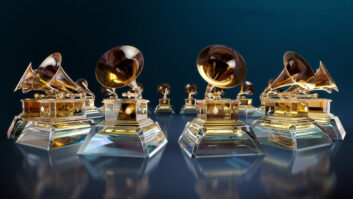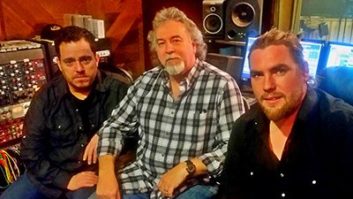Just how long is Brian Gardner’s discography? Well, pulling up his allmusic.com page results in a list of over 750 credits. It was hip hop heavy Dr. Dre who gave Gardner the handle “Big Bass,” so people tend to think of him as purely a hip hop/R&B expert. While there’s no question that he is expert in the genre, those in the know seek him out for mastering expertise on all styles of projects, from alternative to classic jazz. And among those 750-plus credits are such monster hits as Janet Jackson’s Velvet Rope, Blink 182’s Enema of the State, Eminem’s Slim Shady, En Vogue’s Funky Divas, Fastball’s All the Pain Money Can Buy, Smash Mouth’s Astro Lounge and 2 Pac’s All Eyes on Me.
And the hits just keep coming. On the day we spoke, Gardner had six cuts in the Top 10 of Billboard’s Hot 100: Mary J. Blige’s “Family Affair,” Nelly Furtado’s “Turn Off the Light,” “Hero” by Enrique Iglesias, “Get the Party Started” by Pink, and two by Jah Rule: “Livin’ It Up” and “Always on Time.” How’s that for a hot week?
Because in person his vibe is so energetic and youthful, it’s a surprise to discover just how long Gardner has been tweaking knobs in the mastering business. He got his start cutting vinyl, and early on worked in the studio with such notoriously challenging artists as Creedence Clearwater Revival and the Jefferson Airplane.
Maybe it was those early psychedelic experiences that resulted in Gardner’s unflappable demeanor. I’ve personally seen him sit calm and collected, a lightning rod in the kind of violent storm that sometimes strikes when creative artists hit mastering: that last-chance saloon for changes.
We sat down for this interview in Gardner’s suite at Bernie Grundman Mastering in Hollywood. That unpretentious room is where, five days a week, he gets down with DATs, CDs, hard drives and analog tapes of every stripe, turning confusion into cohesion, and individual songs into the complete statement that’s an album.
You actually began your career in the mastering room.
Yes, I started in mastering first, then did some recording. I had always had a desire to get into the industry in some form or another. I was trying to get jobs when I was, like, 12! I didn’t realize that I couldn’t because I was too young! I always enjoyed tweaking — EQ’ing music at home. I always knew you could improve it by adding certain frequencies.
Were you into electronics and building stuff?
No, I just had a basic interest. I played piano when I was young, of course. That’s actually something I regret: not having pursued the piano. But I still have the basic skills, and I have all this MIDI equipment at home. I work on it and think I’ve come up with something good, then I come to work and a client comes in with something they’ve done…and I just put my track aside.
What was your first break?
Bill Robertson at Capitol helped me get my foot in the door and land a job at RCA Records, where my professional career started. I started out in mastering, but when I wasn’t busy I got to go down and second engineer for a lot of big dates. Harry Nillson, the Guess Who, Jefferson Airplane…I was a teenager and it was the late ’60s, so it was quite an experience. Huge mega dates with big artists — Henry Mancini, Vic Damone, The Monkees…
How did you learn to use a lathe?
It was at Century Records, my very first job. It was a custom kind of place, and they cut records for schools and the armed forces. I don’t remember the first session I did. I understood the concept — the transfer of mechanical energy to electronic energy through the cutting head — so it wasn’t any big surprise to me. I learned from watching it and reading about it; just knowing the process.
Of course, at that time, I wasn’t allowed to EQ — back then, you were forbidden to touch what the engineers had done. Your job was just to put it on the disc. “Do not touch this tape; it is perfect!”
And then Creedence Clearwater came along. We kept cutting refs for them over and over, thinking there might be something off on the frequency response. And it still wasn’t right. So I broke out the Fairchild limiters and the Pultecs and I tweaked it, and that kind of changed the whole thing — being able to doctor up tapes.
They liked it better.
Oh, yeah. It was a radical difference. And that’s really where my career changed. Because, after a few years of mastering Creedence hits, they [Creedence] plucked me out of RCA and I went up to Fantasy for four years.
Fantasy Studios: the house that Creedence built.
I was the first employee there. They wanted mastering in there first, before anybody else moved in. It was ’69 or ’70. That was another fun part in my career. Living in Berkeley, hanging out, having the Grateful Dead around. It was a great time — going over to Record Plant in Sausalito for the live KSAN broadcasts, hanging out at Wally Heider’s Studios with Jack Casady and the Airplane.
And that led to the next phase, because after my four years there, I went to Allen Zentz Mastering, where we ruled in the disco department. We did all the Donna Summer records, the Casablanca catalog. That was really something.
Was doing all that disco music the beginning of Brian “Big Bass” Gardner?
Well, kind of. I did Donna Summer, the Village People and all of the George Clinton stuff. Really, the thing that struck me the most at the time was the different levels of stardom that I was working with. I remember doing the Jackson 5’s first record and having Berry Gordy in the room. Having Ike and Tina Turner there, in the room alone with me in the evening. And the Jefferson Airplane memories… seeing Jimi Hendrix loan speakers to them…
So you learned to “go with the flow” from some very talented and eccentric artists.
Yeah, people say that I find a groove. And that is how I try to approach a lot of the stuff we do today. You can go in almost any direction with a project: You can make it real crunched and bright, you can make it hurt, or you can make it warm, mellow and wide. Usually I just go with what I feel. Most of the time it ends up being what my initial EQ was. [Laughs.] But sometimes we go on a big trip — a big circle — trying different things. And then we end up with the original.
To a lot of people, the mastering process is very mysterious.
Well, a lot can be done here. Today, we have projects where recording goes on for months and months, sometimes in different studios, with different producers and engineers. What we have to do is put it all together and make it come up [sounding] the same.
I do miss sequenced albums. And one mix, one version. The projects we get now are in so many different formats. There are a lot of different things you have to know how to use.
It takes a lot more outlay to equip a mastering room today.
It’s just my opinion, but I do think our technology has gone too far sometimes. I mean, who really cares about 26k? Take The Beatles. I don’t think there’s anything above 10 or 12k on all those great-sounding records of theirs. There’s nothing wrong with having the capabilities of capturing that 26k, but it brings in all kinds of other problems. And with our levels today — with having to deal with always operating on the threshold of distortion — well, that’s always fun.
Do you mean that people are sending you stuff cut hotter than ever?
No, not necessarily how it comes in; it’s just they want the end product to jump. They always wonder, “Can’t you make this a little louder?” It keeps moving up and it’s got to stop somewhere. [Laughs.] I’d like to put out a record sometime that’s the lowest out there: “Oh, did you hear that new record? It’s so low. It’s so cool.” But that’s not going to happen. Although Steely Dan put out a record that sounded good and it wasn’t loud. It didn’t have to just slam the levels.
You’re talking about losing dynamic range.
Of course. But a lot of today’s music is enhanced by taking some of those things out — punching it up and giving it less dynamics. That’s the nature of much of the music that’s popular — it’s just more intense.
It seems like the great mastering engineers all started with vinyl. It gave them an understanding of what’s important.
Yes, with vinyl there are certain parameters you have to really be careful of. And sonically…well, sibilance can still be aggravating on CDs, even though it doesn’t splatter like it used to on vinyl. Some of the phase things are still important today, even though there are fewer restrictions on CDs.
You still cut vinyl yourself, right?
All the time. Nelly Furtado, Pink, Jah Rule, Dre — they all have vinyl. Even the soundtracks get put out on it. All the majors will usually release a vinyl. Because of the time factor, with albums running 70 minutes, we have to split them up to four sides just to keep the level competitive.
Really, vinyl is a lost art that wants to go away but can’t. There are too many vinyl lovers out there. People who are into it miss the sound. And although digital is getting a lot better, I’m still an analog guy, basically. In general, I think bringing some analog in somewhere in a project really makes a difference. Preferably, on the basic tracks.
Although, I’ve had full digital projects in here lately that amaze me with how good they sound. But then, I’ve also seen groups come in here with really funky setups that sound fabulous. And then they become stars, money rolls in, they upgrade everything and they lose it — they lose the sound. So you never know.
For a long time, all of you at Grundman avoided using computers.
Our basic philosophy is to stick with the original source, whatever it is. Now, though, we’re using the German [computer] system called Audio Q, which is really amazing. Actually, it’s one of our secret weapons, so I don’t think you should print that. [Laughs.]
Nothing is stock here, everything has been modified. And we’ve always been very particular and careful. We listen to blanks and hear the difference.
Blanks?
CD blanks. We’ll throw away thousands of them if they’re not right. We get samples from manufacturers and make tests and A/B. We listen very carefully before we pick the lot that we’re going to buy. A lot of people think once you’re going D-to-D, it doesn’t matter because it’s all numbers. But you can hear it. Every step makes a difference, and when you add all the subtleties up, the result is dramatic.
So, yes, we’re in the computer age. But there’s so much more to it than just the technical part. You can’t just sit there at a computer and think you’ll make it right. The person sitting there operating the equipment has to be able to feel it to turn the right knobs.
You’re also very particular about the consoles here.
Yes, it’s all discrete. There are no transformers, and all the equalizers are handmade by Karl Bischof and Beno [Thomas “Beno” May]. In some instances, they’ve avoided switches. We’ll actually change the patches, say to the 1630, or to the computer, to avoid switching and to make the signal path better. It’s a pain, but it’s worth it.
And, of course, we went through great expense to make sure that, even for the shortest runs, the wire is the best possible. It really is surprising the difference a cable can make.
What do you monitor on?
Our main speakers are Tannoys. And then I have an array of different ones, from NS-10s to KRKs to the new little Yamahas, which DJ Quik just gave me. Those are kind of interesting: They have a switch on them that makes them sound like NS-10s. And they also have adjusters to give you a little more bottom and make them sound better.
They’re all just another reference point and for clients to listen on. Really, I depend on the main Tannoys. But I also use KRK 7000s. And little Radio Shack Minima 7s.
Those little things? Why are they on the floor?
I like them there. A lot of people have copied me on that. They don’t serve any purpose sitting there in your face; it’s an in-the-next-room, on-the-radio kind of thing. Sometimes they’re turned the other way; I don’t care. It’s a good reference. I usually listen to them at a low level and you can tell a lot. Unfortunately, they don’t make that particular model anymore.
Do people hear things in your room they haven’t heard before?
All the time. And most of the time for the better: “Well, I never heard that before, it’s great.”
Do you listen at home or in the car?
I do still listen to my projects in the car once in a while, if I’m really trying to discern certain things — like long fades. And then I’ll try to talk the client into not letting them go so long! Things like that. But you also have to consider the environment of listening at home; the long fade might work there. Noise and traffic are factors, and sometimes I’ll listen in the car for balances. I have a jeep and a sports car, so it’s, “Let’s see, who am I working with today? Oh, yeah, I’ll bring the jeep.”
Do you listen to radio stations?
That’s another thing that I’ve had the luxury of. Over the years, I’ve often been able to hear stuff on the radio almost instantly, and to experiment with limiting parameters and with EQ and how it translates. Especially with rap stuff: We’ll pick a ref and it’ll be on the air in an hour. Some of the big guys can do that. We can hear it right away, and that’s been really valuable.
I don’t really need to do that anymore; now I pretty much know what goes on and how they limit it to death on the radio. So I’ve learned what kind of limiting you can get away with without it being ruined on the air. I’ve heard some records — good records — but they end up horrible because there are vocals in your face, and all of a sudden the band comes in and they’re gone…you’ve got to know how to work with it so it doesn’t do that.
What converters are you currently using?
We have the DB’s and we also still use Apogees occasionally. Of course, how you hit them, and how you hit all the different variables, the EQs, etc., is very important.
But everything goes through an analog process in your room.
Yes. And that’s where we adjust it and try to make everything fit together, even though they are from different formats.
You can fix a lot…but what things are unfixable?
If a machine was set up wrong. Or if something’s been saturated. In either the analog or digital domain, if they just slammed it — if it’s just crunched and really distorted — there’s nothing to be done about it. You can try and adjust the sonics a bit, but those crunches are always going to be there. Or, sometimes I get projects where it’s almost distorting, but not quite, and the mastering process will bring it out. We have to deal with it, and that can be difficult. Sometimes EQ and level adjusting will work, but sometimes it will really need to be remixed.
So the most common problem is too much level, so that the tape is saturated. Not only is distortion the result, but that kind of saturation takes away the attack. It flattens things out. A kick drum, for instance, becomes all mush, so you don’t feel the real solid slap to it.
Do you prefer to get multiple mixes of a song?
Occasionally when they want a vocal up that’s a help. But to have a lot of mixes of guitar up ¼ dB…I haven’t found that useful.
Okay, you’re mastering some really hardcore stuff. How do you relate to the lyrics?
You have to appreciate all forms of music. There are good elements to all of it, even hardcore rap. But, actually, when I hear a mix initially, I don’t even hear the lyrics. I just hear this whole thing. The lyrics are like another instrument and you’ve got to place them in the right spot.
Speaking of placing things in the right spot, what compressors do you use?
Well, we’ve modified most things; they’re not stock. But we have Dominators, and an SSL-style limiter, which was handmade by Beno in our shop. Really, I use limiting very little. I don’t like to do it. As opposed to what you might think by hearing some of the things I’ve done! I really don’t like to take away attack — I just love that punch. But that SSL is a good one when I do limit. And I bought a Waves L2 when I was over in Germany last year — an Israeli electronic piece of gear. Once in a while, I’ll fire that thing in and it works wonders.
You just have to know by feel what to put in when. Some limiters will deceive you and you won’t hear them suck, but they will still be holding back desirable transients. You always have to A/B to the original, and make sure you’re improving it.
I see a Spatializer among your gear. What do you use that for?
It’s a modified Spatializer, which I will use when the mix is kind of dead. I’ve almost been able to create a miracle with it, on occasion, playing with space and width and then re-EQ’ing. It’s a fun tool to have.
Do you have an overall philosophy for the work that you do?
Let’s see…that would be: “Compress till it sucks, then back off ¼ dB.” [Laughs.] I’m not necessarily a technical person; I go by my ears. To me, the most important thing is what’s coming out of those monitors. That should also be the most important thing to the mixers — what they’re listening to. Some people get caught up in the technical aspects of a mix, and they may have a great-sounding mix in their studio, but their monitors are screwed. And that’s where we have to come in to fix it. To them it was probably great. But sometimes it’s hard to explain that to people.
Do artists and producers generally come to your sessions?
It’s a mixture. Once they’ve done a project with me, they will often just send the masters in. But usually the bigger groups will come. They care. And I like it when they care. No Doubt was just in here — the whole group. That’s kind of neat when they’re interested in having a part in even the segues and spaces between songs.
It’s the last chance.
It is, and I’ve had to do percussion and keyboards, bass…all sorts of things in the mastering room. It’s fun, actually. Sometimes creative people have an idea at the last minute, and we’ll do it. What the heck.
Sometimes there are songs or mixes that just have this magic to them, and that’s what I love, that’s what I reach for. And I’m probably more of an experimenter. I’ve never been afraid to break the rules — in fact, I enjoy breaking the rules.
What kind of rules?
[Laughs.] Well, level, for instance. I guess I have to admit I’ve been responsible for a lot of what I complain about. Because I always went for loud. Not meaning to destroy anything, but…and a lot of the stuff I may have been judged for sounding too crunched is not necessarily my fault, it may have been the mix that I was working with. Because, as I’ve said, we are at the mercy of what the engineer has done. It’s just our job to make it better.
Sometimes you go too far and you have to back off. I don’t mind going too far — try it! If somebody has an idea, I’ll go for it. I remember cutting a Donna Summer song with Bruce Swedien and we kept blowing circuit breakers. “Well, that’s too much — we’d better back it off a half dB.” That’s when we were doing the club records. We had a lot of fun doing that stuff.
So, why do people come to you to master their records?
I hope those who chose me like me! And I guess they like the end result. Maybe they also enjoy working here — which they should — it’s fun working here. And those who haven’t been here owe it to themselves to come here — there’s a plug! There’s a lot of people I haven’t worked with yet that I’d like to.
For the last few years, R&B and hip hop have been predominant for me, but, liking all forms of music, I want to do it all. I’m looking forward to compressing the heck out of a classical piece one of these days. Just kidding! But I do like my work; it’s always fun to make things better.
Maureen Droney is Mix’s L.A. editor.
SELECTED CREDITS
Beck:Midnite Vultures (1999)
Blink 182:The Mark, Tom and Travis Show (The Enema Strikes Back) (2000), Enema of the State (1999), Dude Ranch (1997)
Bone Thugs-N-Harmony:E 1999 Eternal (1999, re-release), The Art of War (1997), “Creepin on Ah Come Up” (1994)
Cypress Hill:Stoned Raiders (2001), Skull & Bones (clean, 2000)
Destiny’s Child:Destiny’s Child (1998)
Eazy-E:Str8 off Tha Streetz of MuthaPhukkin Compton (1998), Eternal E (1995), It’s On (Dr. Dre) 187um Killa (1993)
Emperor’s New Groove soundtrack (2000)
Eric Benet:True to Myself (1996)
Fastball:The Harsh Light of Day (2000), All the Pain Money Can Buy (1998)
Herb Alpert:Colors (1999), Passion Dance (1997), North on South St. (1991)
How Stella Got Her Groove Back soundtrack (1998)
Ice Cube:Greatest Hits (2001), War & Peace, Vol. 2 (The Peace Disc) (2000)
The Isley Brothers:Tracks of Life (1991), Spend the Night (1989), Smooth Sailin’ (1987)
Mission Impossible 2 soundtrack (2000)
No Doubt:Rock Steady (2001)
Prince: “1999” (new master) (1999), Crystal Ball (1998), New Power Soul (1998)
Smash Mouth:Smash Mouth (2001), Astro Lounge (1999), Fush Yu Mang (1997)
Suicidal Tendencies:Freedumb (1999), Prime Cuts: The Best of Suicidal Tendencies (1997), Friends & Family (1997)




